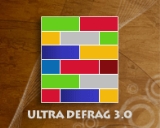
UltraDefrag
Encyclopedia
UltraDefrag is an open-source
disk defragmenting utility
for Microsoft Windows
. It is released under the GNU
General Public License
. The only other Windows-based defragmentation utility with a GNU GPL is JkDefrag
(GPL version discontinued since 2008).
UltraDefrag uses Microsoft's
defragmentation API
and works on Windows NT, 2000, XP, Server 2003, Vista, and 7 operating systems. It supports FAT
12/16/32 and NTFS
file systems and, on Windows Vista and later, the Universal Disk Format
(UDF).
Open-source software
Open-source software is computer software that is available in source code form: the source code and certain other rights normally reserved for copyright holders are provided under a software license that permits users to study, change, improve and at times also to distribute the software.Open...
disk defragmenting utility
Defragmentation
In the maintenance of file systems, defragmentation is a process that reduces the amount of fragmentation. It does this by physically organizing the contents of the mass storage device used to store files into the smallest number of contiguous regions . It also attempts to create larger regions of...
for Microsoft Windows
Microsoft Windows
Microsoft Windows is a series of operating systems produced by Microsoft.Microsoft introduced an operating environment named Windows on November 20, 1985 as an add-on to MS-DOS in response to the growing interest in graphical user interfaces . Microsoft Windows came to dominate the world's personal...
. It is released under the GNU
GNU
GNU is a Unix-like computer operating system developed by the GNU project, ultimately aiming to be a "complete Unix-compatible software system"...
General Public License
GNU General Public License
The GNU General Public License is the most widely used free software license, originally written by Richard Stallman for the GNU Project....
. The only other Windows-based defragmentation utility with a GNU GPL is JkDefrag
JkDefrag
MyDefrag is a freeware disk defragmenting utility for Windows. JkDefrag was developed by Jeroen Kessels from 2004. The major change between JkDefrag and MyDefrag is the inclusion of a scripting language. This permits control of all the algorithms and techniques used in MyDefrag...
(GPL version discontinued since 2008).
History
UltraDefrag was originally written by Dmitri Arkhangelski in 2007, who was later joined by Justin Dearing who wrote an original user manual and UltraDefrag Scheduler application. Later Sayem Chaklader joined the team to completely redesign the project's website. Also he improved graphics belonging to the project. In the year 2009 Stefan Pendl joined the team. Most new features and improvements since that time were invented by him.Features
- Defragments system files (registry, pagefiles...)
- Fast NTFS analysis compared to some other products
- Fast and effective operation (completely defragments without additional passes)
- Safe operation to prevent file damage
- Ability to defragment single file/directory from the context menu in Explorer
- Ability to defragment Alternate Data Streams attached to NTFS files
- Ability to exclude any unimportant files based on flexible filters
- Ability to defragment files which have number of fragments above specified threshold
- Ability to automatically break defragmentation when the specified time interval elapses
- Human-readable HTML reports
- Powerful command line interface
- Ability to automatically hibernate/shutdown PC after a job
- Ability to make an automatic effective defragmentation through Windows Task Scheduler
- Multilingual graphical interface
- Small binaries (less than 500 KiBKibibyteThe kibibyte is a multiple of the unit byte for quantities of digital information. The binary prefix kibi means 1024; therefore, 1 kibibyte is . The unit symbol for the kibibyte is KiB. The unit was established by the International Electrotechnical Commission in 1999 and has been accepted for use...
) - Portable version available which requires no installation
- Native 64-bit support
- Open-source code licensed under the GNU General Public License
UltraDefrag uses Microsoft's
Microsoft
Microsoft Corporation is an American public multinational corporation headquartered in Redmond, Washington, USA that develops, manufactures, licenses, and supports a wide range of products and services predominantly related to computing through its various product divisions...
defragmentation API
Application programming interface
An application programming interface is a source code based specification intended to be used as an interface by software components to communicate with each other...
and works on Windows NT, 2000, XP, Server 2003, Vista, and 7 operating systems. It supports FAT
File Allocation Table
File Allocation Table is a computer file system architecture now widely used on many computer systems and most memory cards, such as those used with digital cameras. FAT file systems are commonly found on floppy disks, flash memory cards, digital cameras, and many other portable devices because of...
NTFS
NTFS is the standard file system of Windows NT, including its later versions Windows 2000, Windows XP, Windows Server 2003, Windows Server 2008, Windows Vista, and Windows 7....
file systems and, on Windows Vista and later, the Universal Disk Format
Universal Disk Format
Universal Disk Format is an implementation of the specification known as ISO/IEC 13346 and ECMA-167 and is an open vendor-neutral file system for computer data storage for a broad range of media. In practice, it has been most widely used for DVDs and newer optical disc formats, supplanting ISO 9660...
(UDF).
See also
- List of defragmentation software
- Comparison of defragmentation softwareComparison of defragmentation software-Comparison:...
- File system fragmentationFile system fragmentationIn computing, file system fragmentation, sometimes called file system aging, is the inability of a file system to lay out related data sequentially , an inherent phenomenon in storage-backed file systems that allow in-place modification of their contents. It is a special case of data fragmentation...

